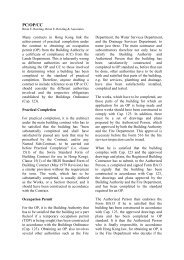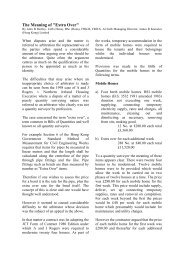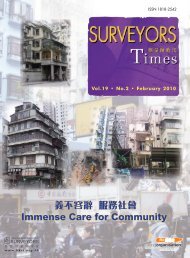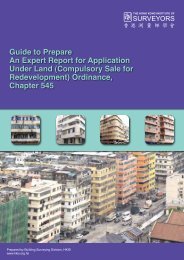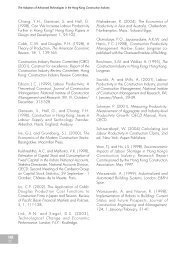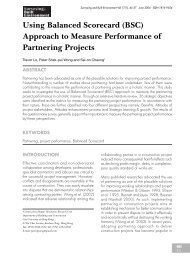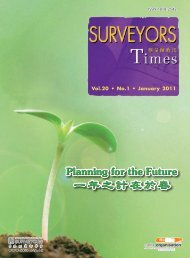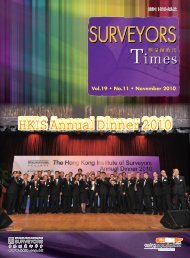Surveying & Built Environment Vol. 22 Issue 1 (December 2012)
Surveying & Built Environment Vol. 22 Issue 1 (December 2012)
Surveying & Built Environment Vol. 22 Issue 1 (December 2012)
Create successful ePaper yourself
Turn your PDF publications into a flip-book with our unique Google optimized e-Paper software.
SBE<br />
16<br />
A Note on British Blockhouses in Hong Kong<br />
The strategic situation remained little<br />
changed for some time. With China<br />
distracted by internal conflict and<br />
European Powers’ resources directed<br />
towards the First World War, the<br />
pressure on Hong Kong was removed.<br />
With those conflicts settled, it was<br />
time to re-evaluate Britain’s strategic<br />
position in Asia.<br />
In the period 1920 to 19<strong>22</strong>, the Hong<br />
Kong situation was reviewed at length,<br />
with the priority now being on dealing<br />
with a Chinese attack across the New<br />
Territories. It was considered that,<br />
where previously an attack would have<br />
been on a small scale, the improvement<br />
in organisation and tactics within the<br />
Chinese Army could see Hong Kong<br />
facing a force 50,000 strong and,<br />
with the rail line between Canton and<br />
Hankow soon to be completed, a further<br />
30,000 men could be available within<br />
a further two months. Also in 19<strong>22</strong>,<br />
Britain, the USA and Japan signed the<br />
Washington Treaty that guaranteed<br />
among its articles, in return for other<br />
concessions, that Hong Kong would<br />
not become more heavily fortified.<br />
Whilst this was primarily intended to<br />
cover naval forces and coastal artillery,<br />
it was applied as a ‘status quo’ for all<br />
defences.<br />
Faced with a Chinese force of that<br />
size, it was unlikely that Hong Kong<br />
could be defended for any great length<br />
of time with its existing garrison (5<br />
Infantry Battalions plus Artillery<br />
and Engineers). There were many<br />
advantages in defending a line near the<br />
border (called the Blue Line in defence<br />
plans), but its length, and the length<br />
of the coastline to be defended behind<br />
it made it impracticable. Pending any<br />
increase in the size of the garrison, the<br />
main line of defence would be across<br />
the narrowest part of the Peninsula<br />
between Tide Cove and Gin Drinkers<br />
Bay (Red Line), with a subsidiary line<br />
(Brown Line) between Tide Cove and<br />
Hebe Haven to prevent raids by small<br />
parties under cover of darkness. Whilst<br />
the position of the Red Line would not<br />
prevent long-range artillery fire from<br />
hitting parts of the Island, it was the<br />
only line that could be economically<br />
held for a considerable time by the<br />
existing garrison.<br />
There were three lines of Chinese attack<br />
considered by the defence planners 13 ;<br />
the coast road along the shores of Tolo<br />
Harbour and Tide Cove from Taipo,<br />
a track over Lead Mine Pass towards<br />
Smuggler’s Ridge and Golden Hill,<br />
or another track further west over<br />
the comparatively high pass on the<br />
west side of the Tai-Mo-Shan Ridge<br />
towards the coast, thence towards<br />
Golden Hill. As long as the Royal Navy<br />
had command of the sea, the use on<br />
any scale of either the Coast Road on<br />
the East or an attack on Golden Hill<br />
from the west would be a somewhat<br />
precarious operation for the enemy. The<br />
most likely attack was considered to be<br />
in the centre of the line, in the vicinity<br />
of Smugglers’ Ridge. Delaying tactics<br />
would be employed forward of the line<br />
for as long as possible, to gain time for<br />
local reinforcements to arrive. It was<br />
13 The various lines of attack come from WO 32/5303 Defence of Hong Kong against Chinese Forces<br />
1920-<strong>22</strong>, in the form of an ‘Appreciation from GOC to War Office’, and subsequent correspondence.<br />
This document also has the earliest seen copy of the map showing the Blue, Brown and Red lines.




